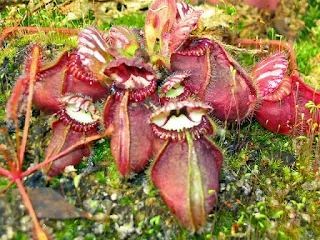Carnivorous plants are plants that derive some or most of their nutrients (but not energy) from trapping and consuming animals or protozoans, typically insects and other arthropods. Carnivorous plants have adapted to grow in places where the soil is thin or poor in nutrients, especially nitrogen, such as acidic bogs and rock outcroppings. Charles Darwin wrote Insectivorous Plants, the first well-known treatise on carnivorous plants, in 1875.
True carnivore is thought to have evolved independently six times in five different orders of flowering plants, and these are now represented by more than a dozen genera. These include about 630 species that attract and trap prey, produce digestive enzymes, and absorb the resulting available nutrients. Additionally, over 300 proto carnivorous plant species in several genera show some but not all these characteristics.
True carnivore is thought to have evolved independently six times in five different orders of flowering plants, and these are now represented by more than a dozen genera. These include about 630 species that attract and trap prey, produce digestive enzymes, and absorb the resulting available nutrients. Additionally, over 300 proto carnivorous plant species in several genera show some but not all these characteristics.
Five basic trapping mechanisms are found in carnivorous plants.
1. Pitfall traps (pitcher plants) trap prey in a rolled leaf that contains a pool of digestive enzymes or bacteria.
2. Flypaper traps use a sticky mucilage.
3. Snap traps utilize rapid leaf movements.
4. Bladder traps suck in prey with a bladder that generates an internal vacuum.
5. Lobster-pot traps force prey to move towards a digestive organ with inward-pointing hairs.
These traps may be active or passive, depending on whether movement aids the capture of prey. For example, Triphyophyllum is a passive flypaper that secretes mucilage, but whose leaves do not grow or move in response to prey capture. Meanwhile, sundews are active flypaper traps whose leaves undergo rapid acid growth, which is an expansion of individual cells as opposed to cell division. The rapid acid growth allows the sundew tentacles to bend, aiding in the retention and digestion of prey.
The sundew species Drosera glanduligera employs a unique trapping mechanism with features of both flypaper and snap traps; this has been termed a catapult-flypaper trap.
The evolution of carnivorous plants is obscured by the paucity of their fossil record. Very few fossils have been found, and then usually only as seed or pollen. Carnivorous plants are generally herbs, and their traps are produced by primary growth. They generally do not form readily fossilisable structures such as thick bark or wood. Still, much can be deduced from the structure of current traps and their ecological interactions. It is widely believed that carnivory evolved as a method to increase nutrients in extremely nutrient poor conditions, leading to a cost-benefit model for botanical carnivory. Cost-benefit models are given under the assumption that there is a set amount of energy potentially available for an organism, which leads to trade-offs when energy is allocated to certain functions to maximize competitive ability and fitness. For carnivory, the trait could only evolve if the increase in nutrients from prey capture exceeded the cost of investment in carnivorous adaptations.
Most carnivorous plants live in habitats with high light, waterlogged soils, and extremely low soil nitrogen and phosphorus, producing the ecological impetus to derive nitrogen from an alternate source. High light environments allowed for the trade off between photosynthetic leaves and prey capturing traps that are photo synthetically inefficient. To compensate for photo synthetically inefficient material, the nutrients obtained through carnivore would need to increase photosynthesis by investing in more leaf mass, i.e. growing. This means when there is a shortage of nutrients and enough light and water, prey capture and digestion has the greatest impact on photosynthetic gains, favoring the evolution of plant adaptations which allowed for more effective and efficient carnivore. Due to the large amount of energy and resources allocated to carnivorous adaptations. i.e. the production of lures, digestive enzymes, modified leaf structures, and the decreased rate of photosynthesis over total leaf area, some authors argue that carnivory is an evolutionary last resort when nitrogen and phosphorus are limited in an ecosystem.
Carnivorous plants are widespread but rather rare. They are almost entirely restricted to habitats such as bogs, where soil nutrients are extremely limiting, but where sunlight and water are readily available. Only under such extreme conditions is carnivory favored to an extent that makes the adaptations advantageous.













.jpg)

No comments:
Post a Comment
Stay updated with our blog for more quality content! Your feedback is appreciated. Contact us at harshrex@outlook.com with any suggestions.